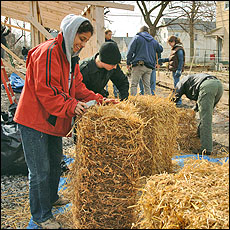Archives
Straw greenhouse rises on West Side
Architecture students find nontraditional building material is strong, efficient
By PATRICIA DONOVAN
Contributing Editor
Contrary to the unhappy experience of the first little pig, straw bale is a strong, cost-effective, exceptionally insulating, fire-resistant, sustainable, natural building system.

Purva Ghate, a graduate student,
uses a packing knife to square off a bale of hay to ensure that the
block will pack tightly with other hay bales. Ghate and other
architecture students are building a greenhouse for the Massachusettes
Avenue Project.
PHOTO: NANCY J. PARISI
On Saturday, UB architecture students and community members—cold, covered in mud and stuck with hay—raised 130 50-pound "two-string" straw bales (14 inches high x 18 inches wide x 35 inches long) that will constitute the load-bearing walls of a community greenhouse on Buffalo's West Side.
The greenhouse was designed and is being built for the Massachusetts Avenue Project (MAP) as part of "Natural Building Systems," a graduate seminar taught by architect and engineer Kevin Connors, adjunct instructor in the UB School of Architecture and Planning, who has a deep interest in sustainable construction.
"We hadn't seen much straw-bale construction since it was used for houses in early 20th-century Nebraska, where trees were few and grass was plenty," Connors says. "Its obvious advantages, however, have helped provoke its comeback over the last 15 years or so."
This Saturday, the community-student group will coat the straw-bale walls with an earth-clay plaster that will become part of the building's skin, along with a resistance coat of lime plaster.
Dave Lanfear of Bale on Bale Construction of Hamburg again will present a building demonstration for the workers on Saturday. His company provides straw-bale construction services, including planning, bale raising and plastering, throughout Western New York and the northeastern United States.
The greenhouse, adjacent to MAP's community garden at 387 Massachusetts Ave., will be used by the organization for "Growing Green," its youth entrepreneurial program that partners garden-based businesses with neighborhood youth, and trains them in sustainable urban agriculture and food systems issues.
Connors says straw bale, so useful in this instance, can be used much more frequently if architects, designers, engineers and the public become familiar with how and why it works so well. That is the educational mission of the project.
"We built the foundation and frame of the greenhouse over the last few weeks," he says, "minimizing the use of concrete with a technique called 'shallow frost-protected foundation.'"
Concrete foundations must be four feet deep in this region to accommodate ground freezing. In this case, rigid insulation was spread on the foundation, limiting the required depth of concrete to 12 inches.
"The roof and at least one wall of the greenhouse will be made of polycarbonate," Connors says, "a strong, lightweight plastic that allows the wall and ceiling to serve as a light source and permit passive solar energy to heat the building in sunny months."
The team used standard techniques to frame the roof, including fabricated steel-plate connections to allow for very rigid posts and beams.
The posts and beams were made of both standard lumber and lumber salvaged from a beautification project on Bailey Avenue. For that project, another group of Connors' students worked with the not-for-profit group Street Synergy to build a neighborhood park at the corner of Bailey Avenue and Dartmouth Street.
Although most people are completely unfamiliar with straw-bale construction, Connors, points out that such buildings are going up all over the country, particularly in the Southwest.
"A bale house is being built in South Wales, N.Y.," he says, "another near Syracuse and a third, in Rochester, is being put up to give the public an opportunity to see it and to assess its cost in comparison to standard construction methods."
Connors emphasizes the fact that straw bale is as insulating as fiberglass, but is much thicker than most rolls of insulation, so it provides a stronger shield against heat and cold.
Straw-bale construction also is fire retardant. The Wall Street Journal reported recently that potential investors are encouraged to learn that plastered straw-bale walls have been proven to be a fire-safe envelope for both residential and commercial buildings. The paper noted that in recent tests, a straw-bale wall satisfactorily withstood more than two hours of 1,700-degree heat and the subsequent hose-down.
Connors says he first was exposed to straw bale at a natural building colloquium in Bath, N.Y., in 2004. Participants of the colloquium began five buildings on the site of the PeaceWeavers, a community of people dedicated to living and building in a way that has a positive impact on the earth.
"There, I learned about straw bale and found it to be a great way of building. Although most projects like this are in rural areas, I saw the greatest need for ecological building in the city."
Straw bale is not the only natural building method studied by Connors' students. During the spring 2006 semester, they collaborated with a civil engineer to test paper-crate construction, in which blocks made of compressed recycled paper are used as walls.
This semester, they experimented with cob, a particularly long-lasting mud-daub building method in which earth, sand and straw—in this case from the Bailey Avenue site—are mixed together and massaged onto a foundation, creating thick, long-lasting, load-bearing walls.
Connors says he is interested in helping to develop a factory cottage industry for the production of sustainable building materials this summer for the Costa Rica Sustainable Futures Program, a collaborative sustainable building project of UB, the University of Maryland, the University of Illinois-Champagne-Urbana, and the Syracuse University School of Forestry and School of Architecture
UB architecture graduate students who participated in Connors' straw-bale seminar are Garrett Wyokoff, Lindsay Clark, Andrew Petrinec, Felix Lomonaco, James Teese, Jr., Susan Voelxen and David Ruperti.
Connors is a principal in Kevin Connors and Associates, a Buffalo architecture, engineering and planning firm dedicated to ecological architecture.
